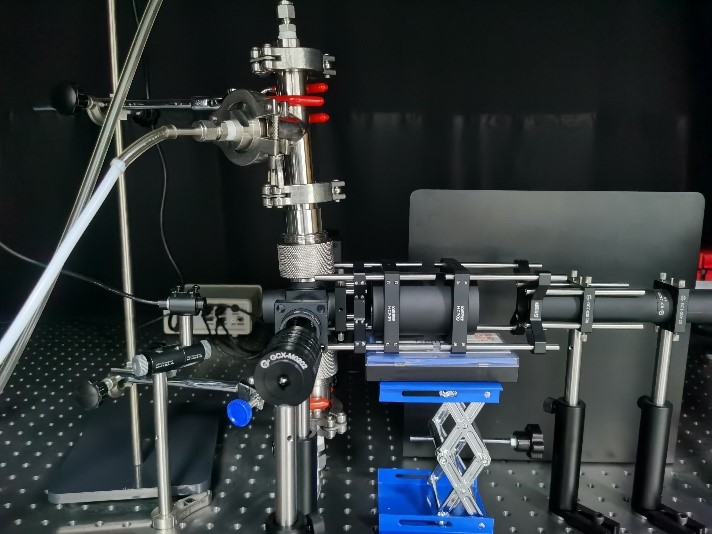悬浮亚微米气溶胶颗粒pH值的在线测量方法的开发
Kuwata Mikinori
pH 值是大气中水相(包括气溶胶颗粒、雾和云滴)物质的最基本的参数之一。pH值被公认能够影响气溶胶颗粒的水相化学过程和人类健康。亚微米气溶胶颗粒在城市大气中占主导地位,但迄今为止仍缺乏直接定量测量其pH值的实验技术,只能通过热力学模式进行估计。这些热力学模式被开发出来的目的是为了估计大气中重要化学物质的气-粒相分配,而非pH值。因此,各个热力学模式间对 pH 值的预测存在差异,需要一种对pH值进行直接测量的实验技术来检验现有各个模式的能力和局限性。
为了解决这个问题,我们开发了一种利用荧光 pH 探针测量悬浮亚微米气溶胶颗粒pH值的新方法。实验设置如图1所示。该仪器的图片如图 2 所示。简而言之,将含有荧光pH探针的颗粒注入气溶胶荧光池 (AFC),使用荧光素和俄勒冈绿488作为 pH 探针。荧光素对pH值5~7的范围敏感,而俄勒冈绿488对pH值2~5的范围敏感。因此,结合两种荧光探针可以对2~7范围内的pH值进行定量测量。AFC中的气溶胶颗粒被两种波长的激光交替照射。选择波长为450和 488 nm的激光,并利用所选探针受两种波长激光的激发的信号比值对pH值进行分析。荧光信号通过带通滤光片,被光电倍增管 (PMT)测量。通过在装置中插入含有pH缓冲溶液和荧光pH探针的比色皿对AFC进行校准。
随后我们将AFC得到的数据与撞击器-pH试纸法进行比较。撞击器-pH试纸法是一种离线测量亚微米气溶胶颗粒pH值的方法。我们将无机与有机缓冲溶液雾化以产生气溶胶颗粒。使用缓冲溶液有利于最大限度地减少离线分析方法产生的干扰。AFC和pH试纸法的数据较为一致,其差异在ΔpH在0.5的范围内。结果表明我们的方法可以测量亚微米颗粒的pH 值,而非通过热力学模式来估计。
我们目前正在利用AFC方法来检验热力学模式预测重要大气化学系统的pH值的能力。
Development of an online method for detecting pH of suspending sub-micrometer particles
pH is one of the most fundamental parameters for aqueous phases in atmosphere, including aerosol particles, fog, and cloud droplets. In the case of aerosol particles, the roles of pH on aqueous phase chemistry and human health have long been recognized. So far, pH of sub- micrometer particles, which dominate particle population in urban atmosphere, has only been estimated by thermodynamic models due to the absence of experimental techniques for directly quantifying it. These thermodynamic models were developed for estimating gas-particle partitioning of atmospherically important chemical species, rather than for estimating pH. As a result, there have been discrepancies among pH predictions by thermodynamic models. An experimental technique for directly sensing pH is needed for testing the capabilities and limitations of the existing models.
For resolving the issue, we invented a new method for measuring pH of suspending sub-micrometer particles using fluorescent pH probes. Figure 1 shows the experimental setup. A picture of the instrument is available in Figure 2. Briefly, particles containing fluorescent pH probes were injected to the aerosol fluorescence cell (AFC). Fluorescein and Oregon Green 488 were employed as pH probes. Fluorescein covers the pH range of 5~7, while Oregon Green 488 is sensitive for the range of pH 2~5. As a result, the combination of the two fluorescent probes allow quantifying pH for the range of pH 2~7. Particles in the AFC were irradiated by two wavelengths of lasers alternatively. The wavelengths of lasers were selected as 450 and 488 nm, facilitating ratiometric analysis of pH by the selected probes. The fluorescence signals were monitored using the photomultiplier tube (PMT) through the bandpass filters. Calibration of the AFC was conducted by inserting a cuvette containing pH buffer solution with fluorescent pH probes.

Figure 1. Experimental setup: (a) flow diagram, (b) structure of the AFC, and (c) optical setup.
图1. 实验装置:(a) 气流装置,(b) AFC结构,(c) 光学装置

Figure 2. Picture of the AFC
图2. AFC装置的照片
The data obtained by the AFC were compared with the impactor-pH paper method. The impactor-pH paper method is an offline method for detecting pH of sub-micrometer particles. Inorganic and organic buffer solutions were nebulized for generating particles. The usage of buffer solution is advantageous in minimizing artifacts induced by the offline analysis. The data from the AFC and pH paper method agreed well within the difference of ΔpH of 0.5. The result demonstrates that pH of sub-micrometer particles is now measurable, rather than only be estimated by thermodynamic models.
We are currently employing the AFC method for testing the capabilities of thermodynamic models for predicting pH of atmospherically important chemical systems.
Reference: Weihan Li and Mikinori Kuwata, Environ. Sci. Technol. 2023, 57, 23, 8701–8707.
